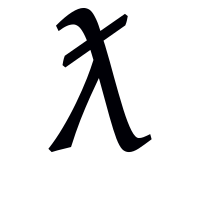The barred lambda, ƛ (U+019B ƛ LATIN SMALL LETTER LAMBDA WITH STROKE), is a modified letter of the Greek alphabet. It is used in Americanist phonetic notation, where it is also known as running man, [1] to transcribe [ t͡ɬ]. In physics, it is used to represent the angular wavelength, i.e. the wavelength (λ) divided by 2π ( τ), which corresponds to the length taken up by one radian of the wave.
It was first used in a phonetics context in American Anthropologist in 1934:
λ for [dl] has been used in Eskimo by Jenness ... ƛ for [tł] is an innovation formed from λ as ł from l. [2]
It is also used for the affricate [t͡ɬ] in transcribing the Sahaptin language, e.g., iƛúpna ‘he jumped’, and it is commonly used for the same purpose in several languages of the Caucasus. In addition, its counterpart with a combining comma above right (U+0315), ƛ̕, is used for many of the Salish languages, such as Klallam, for an ejective lateral affricate.
References
- ^ [1] (strictly speaking, this refers to the glottalized version, [ t͡ɬʼ])
- ^ Herzog, George; Newman, Stanley S.; Sapir, Edward; Swadesh, Mary Haas; Swadesh, Morris; Voegelin, Charles F. (Oct–Dec 1934). "Some orthographic recommendations". American Anthropologist. 36 (4): 629–631. doi: 10.1525/aa.1934.36.4.02a00300.
The barred lambda, ƛ (U+019B ƛ LATIN SMALL LETTER LAMBDA WITH STROKE), is a modified letter of the Greek alphabet. It is used in Americanist phonetic notation, where it is also known as running man, [1] to transcribe [ t͡ɬ]. In physics, it is used to represent the angular wavelength, i.e. the wavelength (λ) divided by 2π ( τ), which corresponds to the length taken up by one radian of the wave.
It was first used in a phonetics context in American Anthropologist in 1934:
λ for [dl] has been used in Eskimo by Jenness ... ƛ for [tł] is an innovation formed from λ as ł from l. [2]
It is also used for the affricate [t͡ɬ] in transcribing the Sahaptin language, e.g., iƛúpna ‘he jumped’, and it is commonly used for the same purpose in several languages of the Caucasus. In addition, its counterpart with a combining comma above right (U+0315), ƛ̕, is used for many of the Salish languages, such as Klallam, for an ejective lateral affricate.
References
- ^ [1] (strictly speaking, this refers to the glottalized version, [ t͡ɬʼ])
- ^ Herzog, George; Newman, Stanley S.; Sapir, Edward; Swadesh, Mary Haas; Swadesh, Morris; Voegelin, Charles F. (Oct–Dec 1934). "Some orthographic recommendations". American Anthropologist. 36 (4): 629–631. doi: 10.1525/aa.1934.36.4.02a00300.

